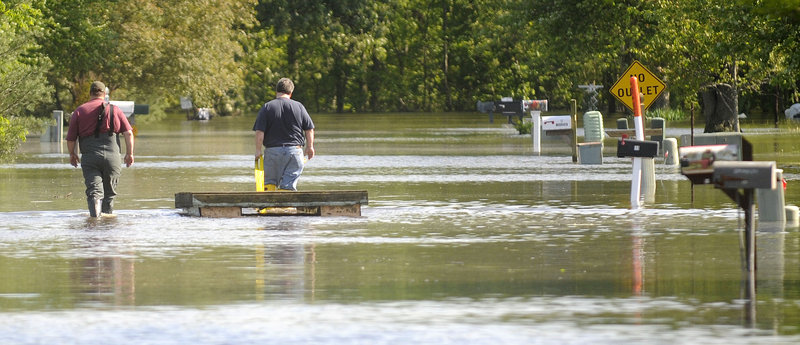HICKMAN, Ky. – People along the lower Mississippi River and its tributaries packed their belongings and emergency workers feverishly filled sandbags as high water pushed its way downstream Wednesday in a slow-motion disaster that could break flood records dating to the 1920s.
From Illinois to Mississippi, thousands of people have already been forced from their homes, and anxiety is rising along with the mighty river, even though it could be a week or two before some of the most severe flooding hits.
“I’ve never seen it this bad,” said 78-year-old Joe Harrison, who has lived in the same house in Hickman since he was 11 months old. Floodwaters from the Mississippi turned his house into an island — dry but surrounded by water. He has been using a boat to get to his car, parked on dry ground along a highway that runs by his house.
Up and down the Big Muddy, farmers braced for a repeat of the desperate strategy employed earlier this week in Missouri, where Army engineers blew up a levee and sacrificed vast stretches of farmland to protect populated areas upstream.
Forecasters and emergency officials said some of the high-water records set during the great floods of 1927 and 1937 could fall. On Wednesday, for example, the Mississippi eclipsed the 46-foot mark set in 1937 in Caruthersville, Mo., and the water was still rising, with a crest of 49.5 feet forecast for Sunday.
But because of the system of levees and locks built since those disasters more than 70 years ago, the flooding this time is unlikely to be anywhere near as devastating as it was back then.
Tom Salem, a meteorologist with the National Weather Service in Memphis, Tenn., said flooding is extreme this year in part because of drenching rain over the past two weeks. In some areas, Wednesday was the first day without rain since April 25.
“It’s been a massive amount of rain for a long period of time. And we’re still getting snowmelt from Montana,” Salem said.
Tributaries that flow into the Mississippi are, in turn, backing up because the river itself is so high. And they account for some of the worst of the flooding so far.
The great flood of the lower Mississippi River Valley in 1927 was one of the biggest natural disasters in U.S. history. More than 23,000 square miles were inundated, hundreds of thousands of people were displaced and about 250 died.
In the aftermath, authorities were criticized for helping rescue whites while leaving thousands of black plantation workers stranded for days without food or drinking water. The flood found its place in folklore, literature and films, and popular songs including “When the Levee Breaks” were written about the disaster.
Another flood in 1937 was also devastating, submerging 31,000 square miles from West Virginia to Louisiana.
Lifelong Hickman resident H.L. Williamson, 77, was a boy when he and his family fled to the highest point in town. He recalled little of the experience except that his brother wouldn’t eat black-eyed peas or grapefruit for years because that was all they had during the flood.
This time, Williamson packed up and left his home, which was still dry thanks to a hill just inches higher than the floodwaters. He took only a few belongings, including the Navy uniform he hopes to be buried in.
The U.S. Army Corps of Engineers’ demolition of a Missouri levee Monday eased flood worries for some communities. In Cairo, Ill., a town of about 2,800 people at the confluence of the Ohio and Mississippi rivers, the Ohio dropped a foot and a half.
But the relief downstream in Kentucky, Arkansas, Tennessee, Mississippi and Louisiana is probably only temporary because the water will eventually find its way back into the Mississippi River.
About 3,800 Kentuckians have left their homes because of flooding.
Hickman, a town of about 2,500, has floodwalls and the river isn’t expected to top them. But officials are worried about water bubbling up through the earthen levee that adjoins the wall. It has been reinforced with about 100,000 sandbags.
Also, a contractor was running 90 dump trucks 24 hours a day between a quarry and the levee in Hickman, bringing in rock to fortify the town’s flood defenses.
Memphis, where the Mississippi was at 43.8 feet Tuesday, could see a crest of 48 feet on May 11, just inches below the record of 48.7 feet set in 1937. Water from the Wolf and Loosahatchie rivers already has seeped into the suburbs, and some mobile home parks were swamped.
Emergency management officials said more than 1,100 houses and apartments could be hit with flooding. Several hundred people have already been evacuated, and thousands more are expected to do the same.
In Louisiana, shippers, ports and the chemical industry are hoping the government can dredge fast enough to keep a major channel into the Gulf of Mexico unclogged.
Send questions/comments to the editors.



Success. Please wait for the page to reload. If the page does not reload within 5 seconds, please refresh the page.
Enter your email and password to access comments.
Hi, to comment on stories you must . This profile is in addition to your subscription and website login.
Already have a commenting profile? .
Invalid username/password.
Please check your email to confirm and complete your registration.
Only subscribers are eligible to post comments. Please subscribe or login first for digital access. Here’s why.
Use the form below to reset your password. When you've submitted your account email, we will send an email with a reset code.